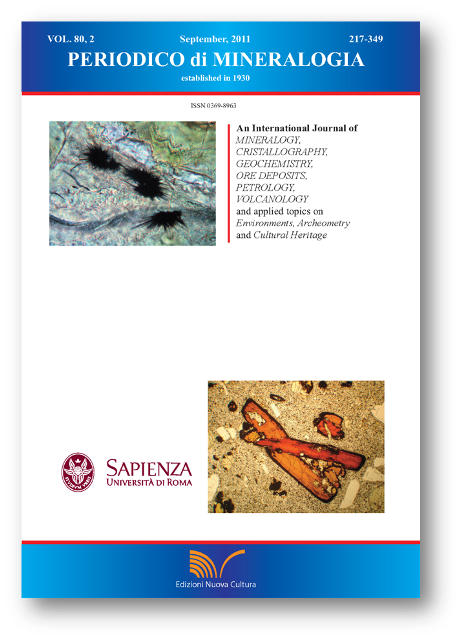Archaeometric characterization of amphorae and bricks of Imperial Age found in a roman villa near the Luzzi town (Cosenza, Calabria, Italy)
DOI:
https://doi.org/10.2451/2011PM0017Keywords:
Ceramic, Keay LII type Amphora, Imperial Roman Age, Petrography, XRD, XRF, Provenance, Raw Materials.Abstract
Periodico di Mineralogia (2011), 80, 2, 217-230 - DOI:10.2451/2011 PM0017
Archaeometric characterization of amphorae and bricks of Imperial Age
found in a roman villa near the Luzzi town (Cosenza, Calabria, Italy)
Anna Maria De Francesco1,*, Tommaso Graziano1, Eliana Andaloro1, Antonio La Marca2, Carmelo Colelli2, Gino M. Crisci1, Eugenio Barrese1 and Marco Bocci1
1Dipartimento di Scienze della Terra - Università della Calabria - 87036 Rende (CS) - Italy
2Dipartimento di Archeologia e Storia delle Arti - Università della Calabria - 87036 Rende (CS) - Italy
*Corresponding author: defrancesco@unical.it
Abstract
The present work illustrates the results of the archaeometric characterization of 10 amphorae fragments of Imperial Roman age and 10 bricks of the same period, found at Muricelle, nearby Luzzi, close to Cosenza in Calabria (Italy). The sherds include amphorae of different shape and production, some of which Keay LII type.
Petrographic study on ceramic fragments using the optic microscope, mineralogical analysis on powders through X-ray diffraction (XRD) and chemical analysis with X-ray fluorescence (XRF) were carried out. Clayey materials from outcrops nearby the archaeological site undergone chemical, mineralogical and granulometric analysis, so as to define their characteristics as potential raw materials for the ceramic production. The realization of experimental firing of the clays, provide information on the technology and firing temperature of the ceramic production.
The obtained results indicate the presence of a probably local production represented by all the bricks; the majority of the amphorae, inclusive of the KLII type amphorae, may have been produced in Calabria on the basis of petrographic evidence, while only three amphorae may be considered as imported ceramics because of the petrographical and chemical composition.
Key words:Ceramic; Keay LII type Amphora; Imperial Roman Age; Petrography; XRD; XRF; Provenance; Raw Materials.


